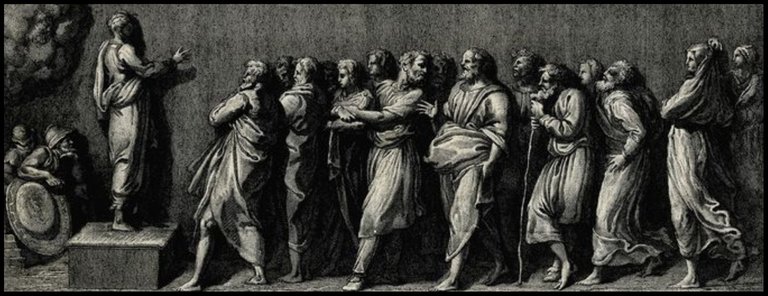
In the last article in this series, we reviewed the Summary List of thirty-one Canaanite kings defeated by Joshua during the Conquest (Joshua 12:9-24). The following nine chapters of the Book of Joshua describe the allotment of the conquered territory among the Twelve Tribes of Israel. Before we can assess the historicity of this distribution we need to ask another question: What are the true origins of the Twelve Tribes?
The traditional answer to this question is to be found in the Book of Deuteronomy, when Moses addresses the Israelites in the following words:
These shall stand upon mount Gerizim to bless the people, when ye are come over Jordan; Simeon, and Levi, and Judah, and Issachar, and Joseph, and Benjamin: And these shall stand upon mount Ebal to curse; Reuben, Gad, and Asher, and Zebulun, Dan, and Naphtali. (Deuteronomy 27:12-13)
These are the names of the twelve sons of the Patriarch Jacob, who was also known as Israel. They are divided into two groups of six—the only time this is done in the Bible. Note that Levi is included as one of the Twelve Tribes, though no territory in Canaan was allotted to the Levites, who constituted the priestly caste of the Israelites. Note also that Joseph is included among the tribes. By the time of the Conquest the Josephites had split into two Half-Tribes, named for Joseph’s sons Manasseh and Ephraim—thus compensating for the loss of Levi among the landed tribes and restoring the number of tribes to twelve. Finally, the order in which the twelve sons are listed is not that in which they were born.
Jacob’s history is recounted in Chapters 25-50 of the Book of Genesis. In Chapter 35, his twelve sons are listed, with their respective mothers:
Now the sons of Jacob were twelve:
The sons of Leah; Reuben, Jacob’s firstborn, and Simeon, and Levi, and Judah, and Issachar, and Zebulun:
The sons of Rachel: Joseph and Benjamin:
And the sons of Bilhah, Rachel’s handmaid; Dan, and Naphtali:
And the sons of Zilpah, Leah's handmaid: Gad, and Asher:
These are the sons of Jacob, which were born to him in Padanaram. (Genesis 30:22-26)
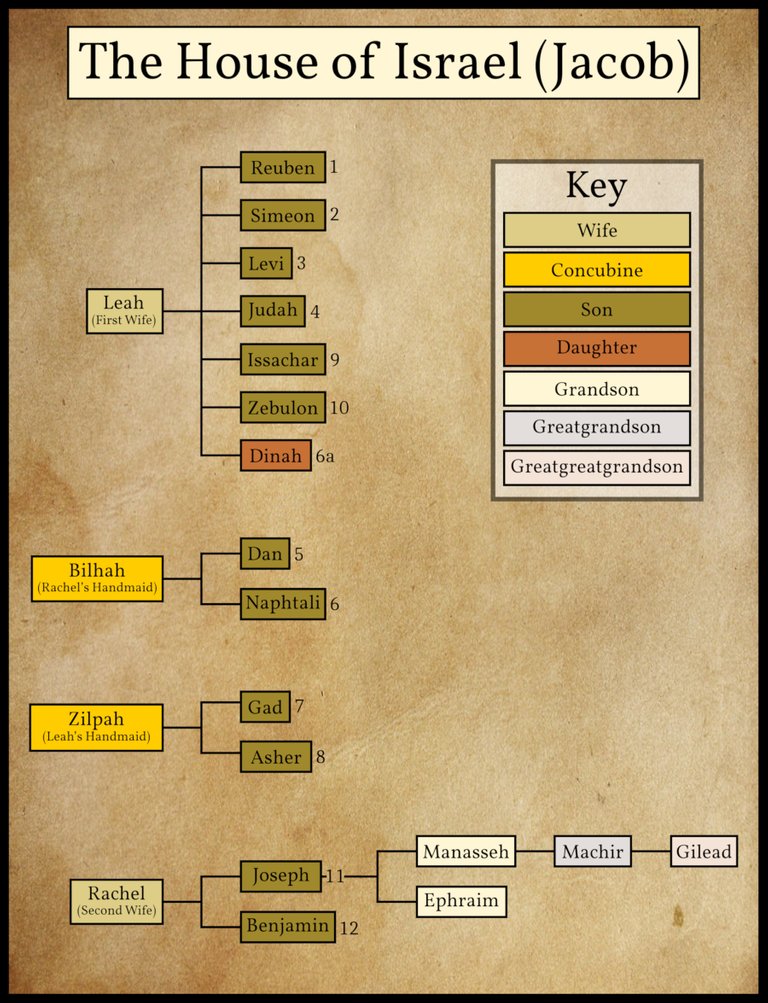
Another succinct list of Jacob’s issue can be found in the First Book of Chronicles:
These were the sons of Israel: Reuben, Simeon, Levi, Judah, Issachar, Zebulun, Dan, Joseph, Benjamin, Naphtali, Gad and Asher. (1 Chronicles 2:1-2
Here, eleven of Jacob’s sons are listed according to their mothers, beginning with the children of Leah, then the two sons of Rachel, and finally the sons of the concubines Bilhah and Zilpah (Berlin & Brettler ). Dan, however, whose mother was Bilhah, is out of place—a detail which may prove to be significant.
Theories on the Origins of the Twelve Tribes
The historicity of the Twelve Tribes of Israel has been much disputed by Biblical scholars. Some argue that while the ancient Israelites were undoubtedly divided into tribes, the number of tribes may not have been fixed at exactly twelve. This number may have had some symbolic or theological significance for the Israelites as part of their national founding myth. The Bible itself is not consistent in numbering or naming the tribes, or in the order in which they are listed:
The Blessing of Jacob (Genesis 49): Reuben, Simeon, Levi, Judah, Zebulun, Issachar, Dan, Gad, Asher, Naphtali, Joseph, and Benjamin. Joseph is singled out for special praise.
The Blessing of Moses (Deuteronomy 33): Reuben, Judah, Levi, Benjamin, Joseph, Zebulun, Issachar, Gad, Dan, Naphtali, and Asher. Simeon is not mentioned. After the tribe of Joseph receives its blessing, Joseph’s sons Ephraim and Manasseh are mentioned as the fathers of ten thousands (Ephraim) and thousands (Manasseh).
An Alternative History of the Conquest of Canaan (Judges 1): Judah, Simeon, the Calebites, the Kenites, Benjamin, Joseph, Manasseh, Ephraim, Zebulun, Asher, Naphtali, and Dan. There is no mention of Issachar, Reuben, Levi, or Gad. The Kenites are the descendants of Moses’ father-in-law, who is not named here (elsewhere in the Bible he is variously identified as Jethro, Reuel, or Hobab). The Calebites are elsewhere identified as a subdivision of Judah. Note how Joseph is once again followed by his two sons. Although it is not clear that these are subdivisions of Joseph, the implication seems to be that the Josephites split into two half-tribes subsequent to the Conquest.
The Song of Deborah (Judges 5:2–31): This song is widely acknowledged to be one of the oldest passages in the Bible. It mentions eight of the traditional tribes and two non-traditional tribes: Ephraim, Benjamin, Machir, Zebulun, Issachar, Reuben, Gilead, Dan, Asher, and Naphtali. According to Numbers 26:29, Machir was the son of Manasseh and Gilead was the son of Machir. The other five traditional tribes (Simeon, Judah, Levi, Manasseh, and Gad) are not mentioned.
1 Chronicles 2, which was quoted above, tries to make sense of all this. But the First Book of Chronicles is probably a late source, written or compiled in the Post-Exilic Era.
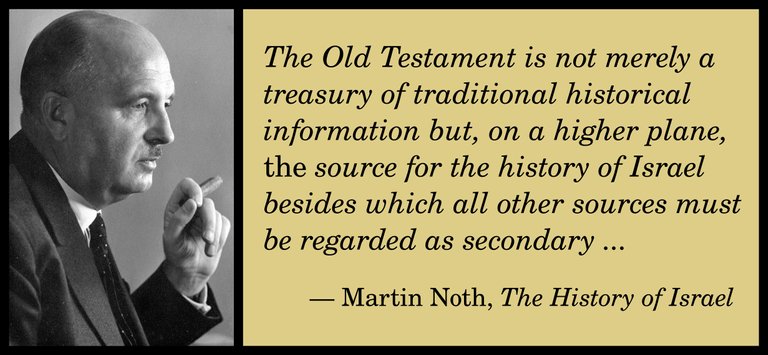
Martin Noth
In 1930, the German scholar Martin Noth hypothesized that the organization of the Israelites into twelve tribes took place at Shechem, between Mounts Ebal and Gerizim, in the immediate aftermath of the settlement (Joshua 24). In Noth’s opinion, there did not exist an Israelite nation or people prior to the colonization of Canaan. Rather, there first existed twelve separate and independent tribes, which formed the confederation known as Israel in the wake of the Canaanite settlement:
’Israel’, which, according to Old Testament tradition, was an association of twelve separate tribes, cannot really be grasped as an historical entity until it becomes a reality living on the soil of Palestine ... the history of Israel, in the strict sense of the history of a more or less definable entity, only begins on the soil of Palestine. (Noth 1960:53)
The story of Jacob and his sons was fabricated as an afterthought to help bind the new nation together. This was part of the Deuteronomistic History (found in the books of Deuteronomy, Joshua, Judges, Samuel and Kings), which Noth believed was based on genuine traditions. But these popular traditions were woven into a continuous narrative much of which was not to be read as historical truth. According to Noth, Joshua’s Conquest of Canaan was a pious fiction. In his words, the settlement of Canaan by the tribes was carried out “fairly quietly and peacefully on the whole and without seriously disturbing the great mass of the previous inhabitants” (Noth 1960:69). The subsequent amalgamation of the tribes into an Israelite nation is ascribed in the Deuteronomistic History to the “Diet of Shechem”:
So far as the twelve-tribe association is concerned, however, we have, to begin with, the story of the ‛diet of Shechem’ in Jos. xxiv, a special section which now exists in a deuteronomistic revised version as a later addition to the deuteronomistic history. According to this, Joshua gathered all the tribes of Israel to Shechem to the holy place (‛before God’) and summoned them to decide whether they desired to serve Yahweh or other gods, and after they had decided for Yahweh he made a covenant between God and people and ‛set them a statute and an ordinance in Shechem’ and in witness thereof ‛took a great stone and set it up there under the oak that was in the sanctuary of Yahweh’. (Noth 1960:92)
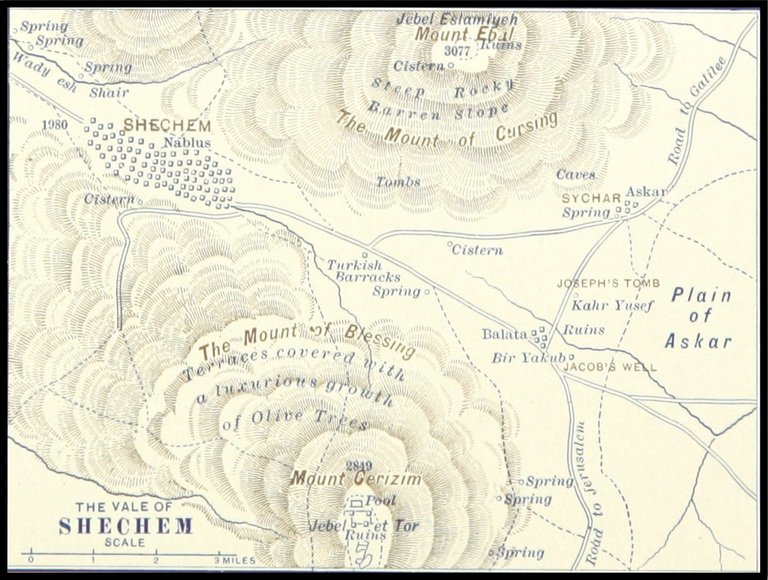
Noth, then, believed that a confederation of twelve tribes dwelt in the wilderness of Transjordan in the Late Bronze Age. These tribes crossed the Jordan and gradually insinuated themselves among the indigenous inhabitants and settled the sparsely populated areas of Canaan. Out of this settlement arose the Israelite nation. This was followed by a period of consolidation, which is recorded in the Book of Judges. In Noth’s approximate chronology, this period lasted about two centuries (1200-1000 BCE).
I agree with Noth that the traditional tribes (however many of them there actually were) predate the existence of the Israelite nation, but this is where I part ways with him. Not only do I reject his conventional dates, but I also believe that the relationship between the Twelve Tribes and the nation of Israel was quite different from the one he envisaged. I believe that the confederation of tribes existed in Canaan—not Transjordan—prior to the settlement of Canaan by the House of Israel. The tribes were originally the Canaanites, not the Israelites.
A Working Hypothesis
I hypothesize that the history of Canaan found in the Book of Judges, according to which the land was shared by twelve confederated tribes, reflects the situation in Canaan when the House of Israel (ie Jacob’s extended family) was dwelling in Egypt. In other words, the Book of Judges should be placed before the Book of Joshua in the Old Testament—or even substituted for it.
This Canaanite confederation was partly conquered by Joshua and the Israelites, and this led to the creation of the Kingdom of Israel in the immediate aftermath of the Conquest. The southern part of Canaan, which was not conquered by the Israelites, formed the rival kingdom of Judah. The House of Israel and the Canaanite tribes were all of the same “race” and spoke dialects of the same North-West Semitic language. After all, the House of Israel was simply a Canaanite family that had migrated from Canaan to Egypt during a famine.
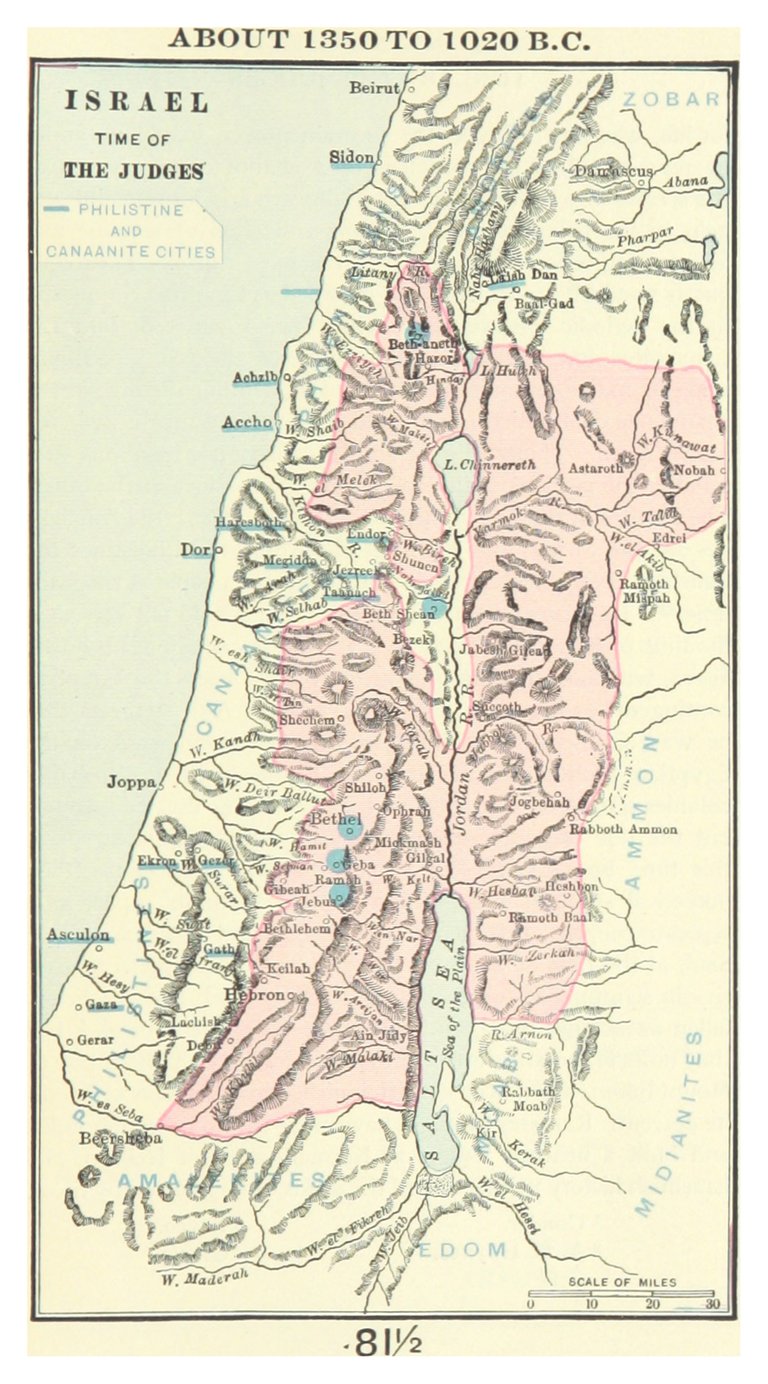
According to this working model, the Judahites were not Israelites who conquered territory for themselves in southern Canaan sometime after the Joshuan Conquest of Northern Canaan—as I hypothesized in a previous article. They were, rather, native Canaanites, who successfully resisted the Joshuan Conquest and then found themselves cut off from their Canaanite confederates. I leave open the possibility, however, that the Judahites did expand their territory in southern Canaan after the Joshuan Conquest. This would have been at the expense of other Canaanite tribes in the region: eg the Kenizzites, the Kenites, the Calebites, and the Jerahmeelites.
A Confederate Canaan
Is there any evidence that Canaan once comprised a confederation of tribes? There is nothing improbable in such an idea. We do know of at least one population of Canaanites who organized their state along confederate lines. The Phoenicians spoke a Northwest Semitic language closely related to Hebrew and other so-called Canaanite languages. They used an alphabet very similar to that used by the ancient Israelites. They even referred to themselves as Canaanites (Quinn & Vella 60). Phoenicia was a loose confederation of quasi-independent city-states. The principal members of this confederacy included Byblos, Tyre, Sidon, Berytus (Beirut), Arwad, Akko (Acre), Athar (Tripoli), Baalbek, and Ugarit. Each city-state had its own king, who ruled with the assistance of a council of elders. Some of the Phoenician cities were powerful enough to rule over others. For example, the city of Tyre was located on a small island off the coast of Phoenicia, but at the height of its power it ruled over a kingdom that included significant parts of the adjacent coastal plain.

But if Canaan was a confederation of a dozen or so states at the time of the Conquest, why does the Book of Joshua list thirty-one kings conquered by the Israelites? Does this large number not refute the hypothesis that Canaan was a confederacy of just twelve tribes? Perhaps this is simply one of the elements of the Deuteronomistic History that are not literally true. Or perhaps the political organization of Canaan was similar to that which prevailed in ancient Ireland: a patchwork of dozens of petty kingdoms, each of which was subject to one of just a handful of much larger “overkingdoms”.
Curiously, the Bible itself provides some evidence that the Canaanites were organized into a small number of states:
And Joshua said, Hereby ye shall know that the living God is among you, and that he will without fail drive out from before you the Canaanites, and the Hittites, and the Hivites, and the Perizzites, and the Girgashites, and the Amorites, and the Jebusites. (Joshua 3:10)
Admittedly, there are only seven nations in this list and none of them have names that resemble any of the traditional tribal names of the Israelites. Variants of this list can be found elsewhere in the Bible: eg Joshua 9:1 and Joshua 11:3. In the Book of Genesis, Canaan’s progeny includes several more:
And Canaan begat Sidon his first born, and Heth, And the Jebusite, and the Amorite, and the Girgasite, And the Hivite, and the Arkite, and the Sinite, And the Arvadite, and the Zemarite, and the Hamathite: and afterward were the families of the Canaanites spread abroad. And the border of the Canaanites was from Sidon, as thou comest to Gerar, unto Gaza; as thou goest, unto Sodom, and Gomorrah, and Admah, and Zeboim, even unto Lasha. (Genesis 10:15-19)
Some of these names have obvious connotations. For instance, the Arvadites were clearly the inhabitants of the state whose capital was the Canaanite or Phoenician city of Arwad. Similarly, the Hamathites were inhabitants of Kingdom of Hamath and the Arkites of Arqa. The remaining names are of uncertain origin. Zemarite might refer to the Phoenician city of Sumur.
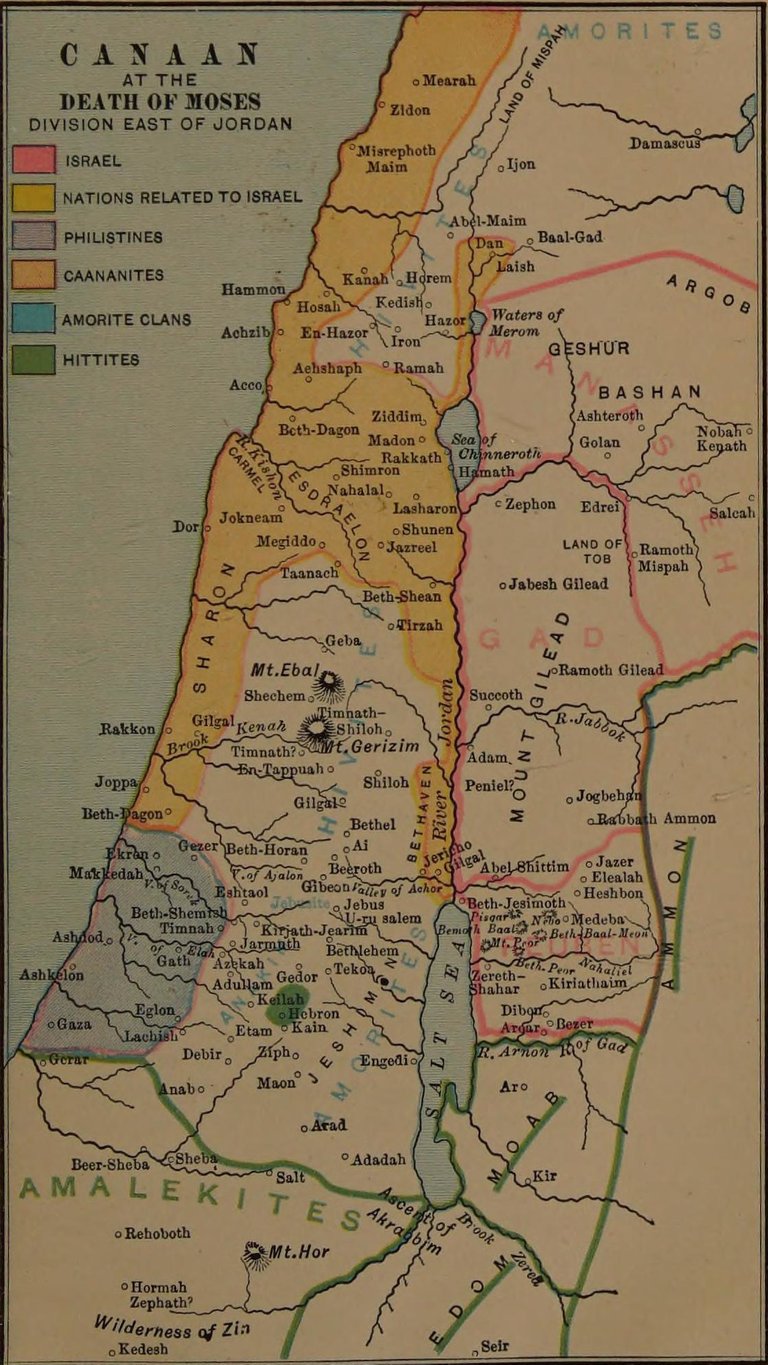
Is there any independent evidence to support the thesis that pre-Conquest Canaan was a confederation of a dozen or so states?
Canaan in the Middle Bronze Age
According to the model of the Short Chronology which I have adopted, the Joshuan Conquest of Canaan took place at the very beginning of the Late Bronze Age, just after the Expulsion of the Hyksos from Egypt and the establishment of the 18th Dynasty. In absolute dates, this occurred around 760 BCE. In the conventional chronology, the absolute date is about 1530 BCE.
The current consensus among archaeologists is that city-states emerged in the Middle Bronze Age as the predominant form of political organization in Canaan, each of which comprised a fortified city and the surrounding hinterland:
Numerous archaeological surveys conducted during the last four decades have contributed tremendously to our knowledge of the socio-cultural landscape of Middle and Late Bronze Age Levantine society ... This period of time is marked by two well-documented shifts in the settlement pattern of Canaan. The first few centuries of the second millennium B.C.E. were characterized by the gradual development of large urban centers during the Middle Bronze Age ... During the sixteenth century, coinciding with the transition from the Middle to the Late Bronze Ages, there was a noteworthy decline in settlement size and urban population. Then, over the course of the Late Bronze Age, the number of settlements gradually increased, reaching its peak during the thirteenth century ... with most of the sites located in the coastal plain and fertile valleys. (Killebrew 97)

According to Ann E Killebrew, Associate Professor of Classics and Ancient Mediterranean Studies, Jewish Studies, and Anthropology at the Pennsylvania State University, the city-state model that emerged during the Middle Bronze Age was still in existence throughout the Late Bronze Age, when Canaan lay within Egypt’s sphere of influence under the 18th (LB I-IIA) and 19th (LB IIB) Dynasties:
Late Bronze Age Canaan was not made up of a single “ethnic” group but consisted of a population whose diversity may be hinted at by the great variety of burial customs and cultic structures ... that one finds. Although the population of Canaan was of varied origins, it was unified by a common socioeconomic system based on a city-state/hinterland model ... Politically and economically, one of the most noteworthy features of the Late Bronze Age was the appearance of centralized administration in large palace complexes. Throughout the eastern Mediterranean region, the palace served as the administrative center and seat of the local ruler in an urban settlement. In the case of the “small kings,” the palaces’ control extended to the respective surrounding hinterland. (Killebrew 12 ... 24-25)
Killebrew’s analysis could be cited in support of my hypothesis, although she draws very different conclusions and her absolute dates are conventional. While acknowledging that there was an obvious disruption to the settlement pattern in Canaan at the end of the Middle Bronze Age, Killebrew emphasizes the cultural continuity:
One should note two other features of second-millennium settlement patterns and their associated cultural and social boundaries. In spite of the reduction in size and number of urban centers during the transition from the Middle and Late Bronze Ages, the material culture is marked by continuity. (Killebrew 97)
Was this disruption caused by the Joshuan Conquest? Killebrew does not think so, as she places the Israelite settlement much later—around 1200 BCE (conventional) at the beginning of the Iron Age (Killebrew 185). She also favours the so-called Mixed Multitude Theory:
Ancient Israel’s mixed multitude is defined here as a collection of loosely organized and largely indigenous, tribal, and kin-based groups whose porous borders permitted penetration by smaller numbers from external groups. Although it is impossible to reconstruct with certainty the protohistory of Israel’s origins, it most likely comprised diverse elements of Late Bronze Age society, namely, the rural Canaanite population, displaced peasants and pastoralists, and lawless ‛apîru and Shasu. Fugitive or runaway Semitic slaves from New Kingdom Egypt may have joined this mixed multitude. Nonindigenous groups mentioned in the biblical narrative, including Midianites, Kenites, and Amalekites (the latter perhaps connected with the control of camel caravan trade routes between Arabia to Canaan), may also have formed an essential element. Egypt’s decline and eventual retreat from Canaan undoubtedly was one of the major contributing factors in Canaan’s return to a more fragmented kinship-based tribal society and Israel’s subsequent ethnogenesis. (Killebrew 184-185)
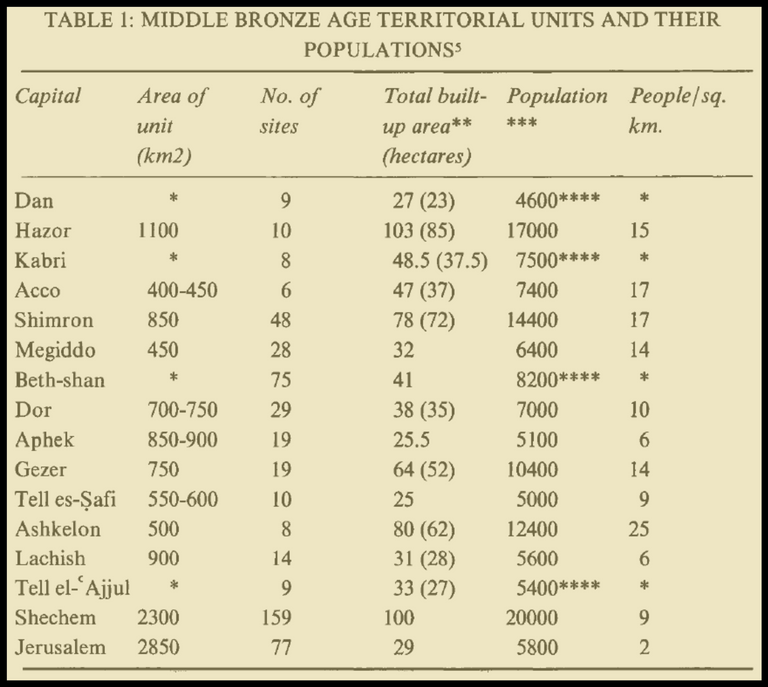
As for the number and size of city-states in Bronze Age Canaan, Israel Finkelstein, Professor Emeritus of Archaeology at Tel Aviv University, has addressed this question in a number of papers. He believes that the number of states in Canaan during the Middle Bronze Age was considerably less than the thirty-odd implied by the Summary List in Joshua 12:
Taking all the above-mentioned factors into consideration, and using the Thiessen polygons system for spatial analysis, the following reconstruction can be suggested:
Seven units for the ca. 65,000 people of the northern valleys and the Galilee, with their centres at: Dan (16 hectares); Hazor (80 hectares, a palace and temples); Kabri (32 hectares, a palace); Acco (20 hectares); Megiddo (6 hectares or more, a palace and a temple); Shimron (25 hectares); an additional site in the Beth-shan valley.
Seven units for the ca. 60,000 people of the central and southern coastal plain and the Shephelah, with their centres at: Dor (10 hectares); Aphek (10 hectares, a palace); Gezer (12 hectares, a high place); Lachish (12 hectares, a palace and a possible shrine); Tell es-Safi (15 hectares); Ashkelon (60 hectares); Tell el-‛Ajjul(12 hectares, a palace).
I would therefore suggest that in the MB II-III there were ca. 16 territorial units in Palestine—two in the highlands and about 14 in the lowlands. (Finkelstein 1992:211-212)
In Finkelstein’s model, the overall number of city-states dropped to 14 during the Late Bronze Age (Finkelstein 1996:221-255). This figure is remarkably close to the Bible’s twelve tribal territories. The agreement between the two is even better when we realize that Finkelstein’s LBA model also includes Philistia, a confederation of city-states that lay outside the tribal territories of the Israelites:
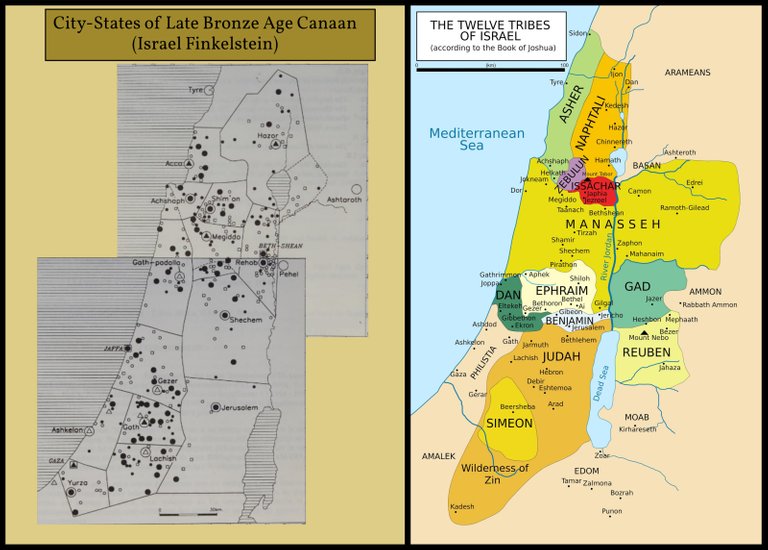
Although Finkelstein’s model of Canaanite city-states has approximately the same number of territories as the Joshuan model of tribal divisions, the borders of his states do not line up well with the traditional tribal borders as described in the Book of Joshua. This, however, need not disconcert us. Finkelstein created his model using the Thiessen polygons system. This is a mathematical method of partitioning an area in such a way that each partition contains one and only one of a finite number of given seed points (Finkelstein’s capital cities), and in such a way that every point within a given partition is closer to that partition’s seed point than to any other seed point. The resulting partition is called a Voronoi diagram. This method may be used to create a first approximation of territorial divisions, but clearly this is not how national boundaries work in the real world. For example, no one would seriously expect to discover that every point within the borders of France lies closer to Paris than to Brussels, London, Madrid, or Berne. It would be bizarre if nations used Voronoi diagrams in support of their territorial claims. In the ancient world, national boundaries were typically defined by natural barriers, such as rivers, mountain ranges and maritime coasts.
I believe, therefore, that Finkelstein’s analysis can be cited in support of my thesis that the traditional tribal divisions were already in existence before the Joshuan Conquest. In other words, the situation that prevails throughout the Book of Judges—Canaan partitioned into a confederation of a dozen or so tribal states before the emergence of the Kingdom of Israel—is a description of Canaan during the sojourn of the House of Israel in Egypt.
Is there any evidence that the Book of Judges is a depiction of Canaan prior to the Conquest? That is what we will investigate in the next article in this series.
And that’s a good place to stop.
References
- Adele Berlin & Marc Zvi Brettler (editors), The Jewish Study Bible, Jewish Publication Society TANAKH Translation, Oxford University Press, Oxford (1999)
- Israel Finkelstein, Middle Bronze Age ‛Fortifications’: A Reflection of Social Organization and Political Formations, Tel Aviv: Journal of the Institute of Archaeology of Tel Aviv University, Volume 19, Issue 2, Pages 201-220, Routledge, Taylor & Francis Group, Milton Park, Abingdon-on-Thames, Oxfordshire (1992)
- Israel Finkelstein, The Territorial-Political System of Canaan in the Late Bronze Age,in Manfried Dietrich & Oswald Loretz (editors), Ugarit-Forschungen: Internationales Jahrbuch für die Altertumskunde Syrien-Palästinas, Volume 28, Pages 221-255, Ugarit-Verlag, Münster (1996)
- Ann E Killebrew, Biblical Peoples And Ethnicity: An Archaeological Study of Egyptians, Canaanites, Philistines, And Early Israel 1300-1100 B.C.E., Society of Biblical Literature, Atlanta, GA (2005)
- Martin Noth, Das System der zwölf Stämme Israels [The Scheme of the Twelve Tribes of Israel], Beiträge zur Wissenschaft vom Alten und Neuen Testament, Band 52, Folge 4, Heft 1, W Kohlhammer, Stuttgart (1930)
- Martin Noth, The History of Israel, Second Edition, Harper & Row, New York (1960)
- Josephine Crawley Quinn, Nicholas C Vella (editors), The Punic Mediterranean: Identities and Identification from Phoenician Settlement to Roman Rule, Cambridge University Press, Cambridge (2014)
Image Credits
- Joshua Addressing the Israelites at Shechem: Anonymous Engraving after Raphael’s Drawing in the Teylers Museum, Haarlem, Netherlands, Public Domain
- Martin Noth: Copyright Unknown, Fair Use
- The Vale of Shechem: Townsend Mac Coun, The Holy Land in Geography and in History, Volume 2, History, Plate 78, Fleming H Revell Company, Chicago (1897), Public Domain
- Canaan in the Time of the Judges: Townsend Mac Coun, The Holy Land in Geography and in History, Volume 2, History, Plate 81½, Fleming H Revell Company, Chicago (1897), Public Domain
- Phoenician Cities: © [Zunkir] (https://commons.wikimedia.org/wiki/User:Zunkir) and Sémhur, Creative Commons License
- Canaan at the Death of Moses: Townsend Mac Coun, The Holy Land in Geography and in History, Volume 2, History, Plate 74, Fleming H Revell Company, Chicago (1897), Public Domain
- Ann Killebrew: © 2021 Claremont Graduate University, Fair Use
- Table of Canaanite City-States in MB II-III (Finkelstein 1992:215): © 1992 Israel Finkelstein, Fair Use
- Finkelstein’s Map of LBA Canaan and The Twelve Tribes of Israel: © 1996 Israel Finkelstein, Fair Use
